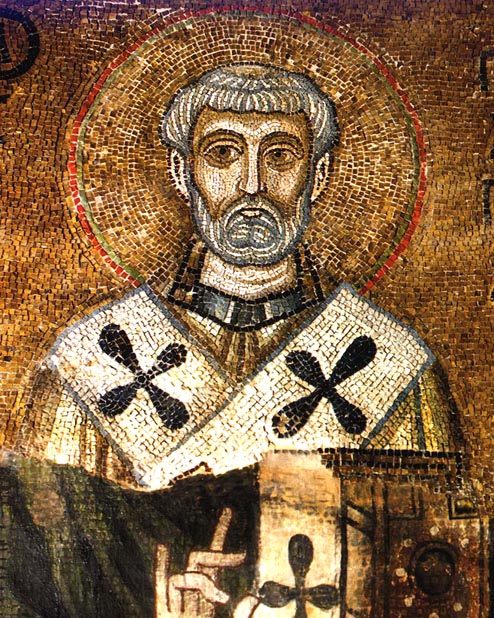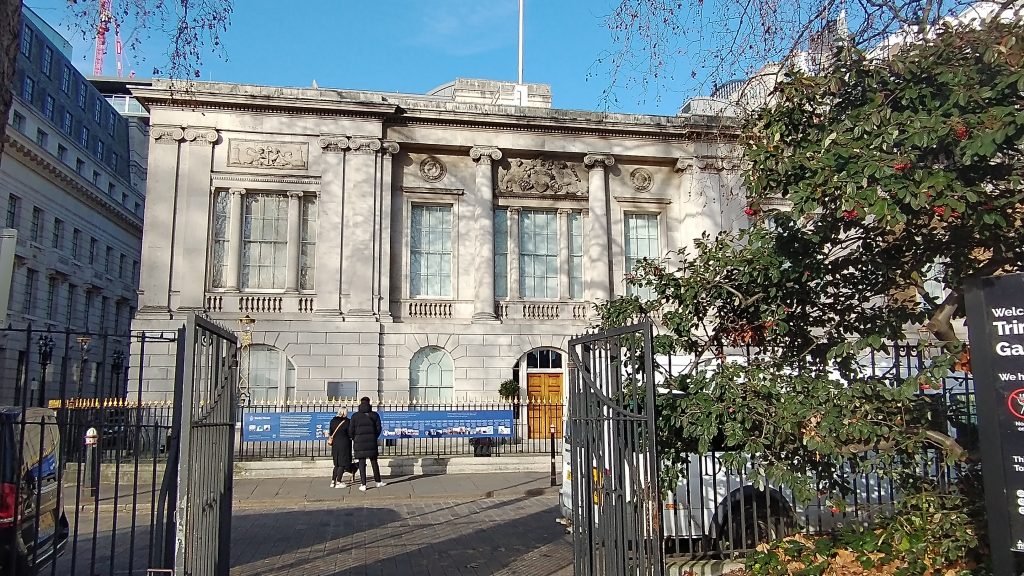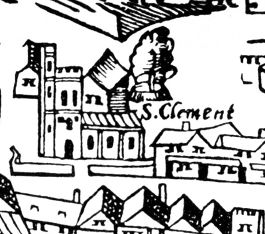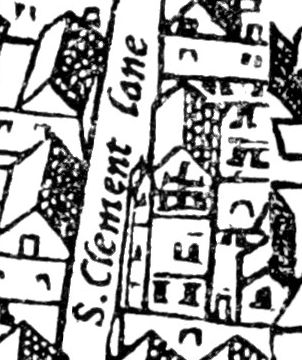
St Clement was a very early Bishop of Rome, shortly after St Peter. Although thought to be a historical and therefore a very important peron in the history of Christianity, his mode of martyrdom is a matter of legend. He is supposed to have been tied to an anchor and thrown in the Black Sea in around AD 99. He is, therefore, particularly venerated by Blacksmiths and Sailors. Others argue that he is earlier than this and place his letter as early as AD60.
Towards the bottom of this post you will find out more about St Clements place in Christian History, but first, lets find out his associations with London.
London & St Clements


The maritime connection may explain the three St Clements connections in London. Trinity House On Tower Hill has been working to keep shipping safe since being founded in Deptford in the 16th Century as:
‘The Master, Wardens and Assistants of the Guild Fraternity or Brotherhood of the most glorious and undivided Trinity and of St Clement in the Parish of Deptford Strond in the County of Kent.
They look after light ships, lighthouses, navigation buoys and licence Deep Sea Pilots. The HQ moved to Tower Hill in 1796.


London has two churches dedicated to St Clements. Both are by early London waterfronts and rebuilt by Christopher Wren and his team.
St Clement’s Eastcheap is on the terrace above the Roman port of London, near London Bridge (which leads to Wikipedia speculation that it might have been an early Roman foundation). And St Clements Danes is where the Strand meets Fleet Street on the terrace above the Lundenwic Saxon waterfront.
Lydia and Wickham get married
St Clements is where Lydia and Wickham finally get married in Jane Austen’s Pride and Prejudice. But which of the two St Clements? Wickham had lodgings in the area. East Cheap area, and the Gardiners, who were the only people at the wedding except Darcy, lived in nearby Gracechurch Street. But perhaps St Clements Dane was more fashionable and might be more the raffish Mr Wickham’s cup of tea? (Jane Austen bought her family’s tea from Twinings, just off Fleet Street, where you can still buy it in their shop? )
Oranges & Lemons
St Clements appears in the nursery rhyme/game Oranges and Lemons and both churches claim it refers to them, but as both are by the waterfront, either will do.
Oranges and lemons,
Say the bells of St. Clement’s.
You owe me five farthings,
Say the bells of St. Martin’s.
When will you pay me?
Say the bells at Old Bailey.
When I grow rich,
Say the bells at Shoreditch.
When will that be?
Say the bells of Stepney.
I do not know,
Says the great bell at Bow.
Here comes a candle to light you to bed,
And here comes a chopper to chop off your head!
Chip chop chip chop the last man is dead
I remember playing this as a child. Two children form an arch with their hands and the other children go through the arch reciting the rhyme until the chopper comes down when the hands forming the arch traps one of the children. The trapped child then whispers which side they want to be one, and they leave the procession to stand behind one or other of the arch-makers. I seem to remember we ended it off by having a tug of war between the two teams.
Alternatively, the trapped/chopped children make an additional arch and the remaining kids have to rush through a large space, fearing the chop.
St Clements and the Early Church
A letter of St Clements survives and is addressed to the Christians of Corinth. This letter is of fundamental importance, as it appears to have been written when the martyrdoms of St Peter and St Paul were relatively recent memories. The letter is also important as a counterargument to the Protestant view that there is no evidence that Peter was ‘Pope’. In this letter, St Clement is giving advice to the Church of Corinth as a Pope would. This can be used as early proof of Papal supervision of the early Church.
The letter is therefore worth reading, and you can read a version of it if you follow the link below. I have chosen two extracts from a long letter. (You can read the whole letter here). The first letter illustrates how close to the deaths of Peter and Paul it was. The second extract gives a great view of an early Christian World View. I think there is also very little here that a Pagan would object to? The main message of the letter is to follow the example of Jesus and adopt humility.
Chapter 5. No Less Evils Have Arisen from the Same Source in the Most Recent Times. The Martyrdom of Peter and Paul.
But not to dwell upon ancient examples, let us come to the most recent spiritual heroes. Let us take the noble examples furnished in our own generation. Through envy and jealousy the greatest and most righteous pillars [of the church] have been persecuted and put to death. Let us set before our eyes the illustrious apostles. Peter, through unrighteous envy, endured not one or two, but numerous labours; and when he had at length suffered martyrdom, departed to the place of glory due to him. Owing to envy, Paul also obtained the reward of patient endurance, after being seven times thrown into captivity, compelled to flee, and stoned. After preaching both in the east and west, he gained the illustrious reputation due to his faith, having taught righteousness to the whole world, and come to the extreme limit of the west, and suffered martyrdom under the prefects. Thus was he removed from the world, and went into the holy place, having proved himself a striking example of patience.
Chapter 20. The Peace and Harmony of the Universe.
The heavens, revolving under His government, are subject to Him in peace. Day and night run the course appointed by Him, in no wise hindering each other. The sun and moon, with the companies of the stars, roll on in harmony according to His command, within their prescribed limits, and without any deviation. The fruitful earth, according to His will, brings forth food in abundance, at the proper seasons, for man and beast and all the living beings upon it, never hesitating, nor changing any of the ordinances which He has fixed. The unsearchable places of abysses, and the indescribable arrangements of the lower world, are restrained by the same laws. The vast unmeasurable sea, gathered together by His working into various basins, never passes beyond the bounds placed around it, but does as He has commanded. For He said, Thus far shall you come, and your waves shall be broken within you.
Job 38:11 The ocean, impassable to man and the worlds beyond it, are regulated by the same enactments of the Lord. The seasons of spring, summer, autumn, and winter, peacefully give place to one another. The winds in their several quarters fulfil, at the proper time, their service without hindrance. The ever-flowing fountains, formed both for enjoyment and health, furnish without fail their breasts for the life of men. The very smallest of living beings meet together in peace and concord. All these the great Creator and Lord of all has appointed to exist in peace and harmony; while He does good to all, but most abundantly to us who have fled for refuge to His compassions through Jesus Christ our Lord, to whom be glory and majesty for ever and ever. Amen.
https://www.newadvent.org/fathers/1010.htm (Translated by John Keith. From Ante-Nicene Fathers, Vol. 9. Edited by Allan Menzies. Revised and edited for New Advent by Kevin Knight. )
Originally published Nov 23rd 2022. Revised & Rewritten on Nov 23rd 2023
Discover more from And Did Those Feet
Subscribe to get the latest posts sent to your email.
